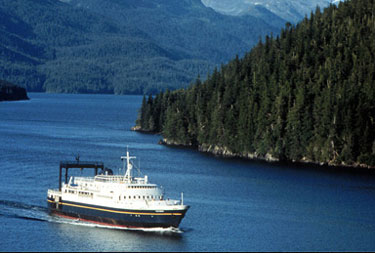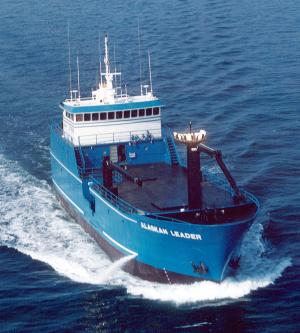
From The Desk of a PMO
Rich Courtney, Port Meteorological Officer, Kodiak, AlaskaG'day...Rich, your PMO in Kodiak, Alaska here. The VOS program efforts in Alaska center on taking advantage of the numerous coastal craft to supply weather observations, for forecast verification and updates. There are three types of vessels providing the bulk of ship observation collection efforts. These are tug & barge operations, ferries and fishing boats.
Tug & barge operations center on the supply of fuel products and hauling cargo to most of the Alaskan coastal communities from Prudhoe Bay, on the North Slope, to Ketchikan in southeast Alaska. Late spring and summer starts the push of the re-supply effort. With the arrival of fall, things are winding down in the re-supply effort. Stronger seasonal storms and severe superstructure icing limit movement and winter stops all efforts for these crews north of Bristol Bay. Honors go to Sea Coast towing tugs Pacific Raven, (WDB7583) with over 1600 observations and Pacific Challenger, (WDA3588) with close to 1100 observations.
Ferries run throughout the year, principally from Bellingham Washington to Haines, Alaska. A second arm runs from Cordova to Whittier and Homer to Kodiak. Weather sensitive, the ferries rely upon the coastal waters forecasts to accurately plan their trips and minimize the effects upon passengers and vehicles. Plying the inner channel areas these observations are critical to forecasting the strong wind events that accompany the oceanic storms in the winter. Our top reporter in this area is Alaska Marine Highway ferry Tustumena, (WNGW) with 350 observations, mostly reported by e-mail.
|
Finally, fishing vessels have made a significant contribution throughout the year by reporting their at sea conditions. These hearty crafts and their crews spend as little as 24 hours at sea, to four weeks plying the close in waters and out into the Bering Sea. Weather conditions impact on whether a vessel can deploy or retrieve trawls, long lines, or pots for a variety of fish and crab species. As of the end of October, fishing vessel Alaskan Leader, (WDB7918) has contributed over 325 weather observations, most of which are located in the fertile fishing grounds of the Eastern Bering Sea.
The National Weather Service uses a variety of methods to collect weather observations. In addition to using GMDSS and Sat-C, we train crews to report weather observations via e-mail, HF/SSB radio and satellite telephone. Most of our tugs report the synoptic coded weather observations via e-mail to an e-mail address in the Alaskan Region Headquarters. These observations are then forwarded to the NWS Telecommunications Gateway for ingestion and dissemination to a variety of foreign and domestic users. The second and third methods rely on voice to collect the information. Calls, via HF/SSB can be made on 4125 kHz to any of seven weather offices, performing a continuous weather watch. With offices in Barrow, Nome, King Salmon, Kodiak, Yakutat, Cold Bay & Annette Island, NWS staffs collect the information and encode the observations for transmission using a piece of software designed by the Alaska Region. With the price of satellite communications beginning to decrease significantly, the Valdez Office uses a satellite phone to receive the observations, encode them and transmit them to the Telecomm gateway. This system uses a flat fee cost to allow unlimited voice access to the NWS. Fishing vessels and suitably equipped tugs can easily talk with NWS personnel about impending forecasts and supply an observation to verify the accuracy of a forecast in their area.
With the largest coast line in the US, meteorologists have a difficult job tracking weather. Thankfully, many of the mariners from merchant marine to fishing vessels have stepped up to the plate with their local conditions to help decipher the oceanic weather puzzle.
Page last modified:

